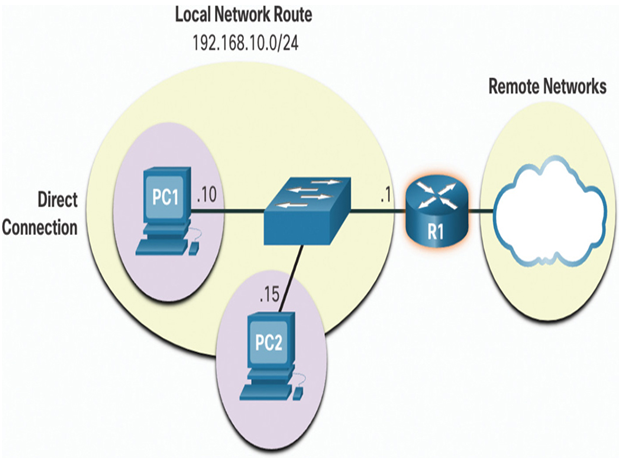The default gateway is the network device (i.e., router or Layer 3 switch) that can route traffic to other networks. If you use the analogy that a network is like a room, then the default gateway is like a doorway. If you want to get to another room or network you need to find the doorway.
On a network, a default gateway is usually a router with these features:
• It has a local IP address in the same address range as other hosts on the local network.
• It can accept data into the local network and forward data out of the local network.
• It routes traffic to other networks.
A default gateway is required to send traffic outside of the local network. Traffic cannot be forwarded outside the local network if there is no default gateway, the default gateway address is not configured, or the default gateway is down.
A Host Routes to the Default Gateway (32.1.3)
A host routing table will typically include a default gateway. In IPv4, the host receives the IPv4 address of the default gateway either dynamically from Dynamic Host Configuration Protocol (DHCP) or configured manually. In IPv6, the router advertises the default gateway address or the host can be configured manually.
In Figure 32-2, PC1 and PC2 are configured with the IPv4 address of 192.168.10.1 as the default gateway.

Figure 32-2 Hosts Use a Default Gateway for Remote Network Access
Having a default gateway configured creates a default route in the routing table of the PC. A default route is the route or pathway your computer will take when it tries to contact a remote network.
Both PC1 and PC2 will have a default route to send all traffic destined to remote networks to R1.
On a Windows host, the route print or netstat -r command can be used to display the host routing table. Both commands generate the same output. The output may seem overwhelming at first, but is fairly simple to understand.
Figure 32-3 displays a sample topology for host routes.

Figure 32-3 Host Route Topology
The output generated by the netstat –r command is shown in Example 32-1.
Example 32-1 IPv4 Routing Table for PC1
C:\Users\PC1>
netstat -r
IPv4 Route Table
===========================================================================
Active Routes:
Network Destination Netmask Gateway Interface Metric
0.0.0.0 0.0.0.0 192.168.10.1 192.168.10.10 25
127.0.0.0 255.0.0.0 On-link 127.0.0.1 306
127.0.0.1 255.255.255.255 On-link 127.0.0.1 306
127.255.255.255 255.255.255.255 On-link 127.0.0.1 306
192.168.10.0 255.255.255.0 On-link 192.168.10.10 281
192.168.10.10 255.255.255.255 On-link 192.168.10.10 281
192.168.10.255 255.255.255.255 On-link 192.168.10.10 281
224.0.0.0 240.0.0.0 On-link 127.0.0.1 306
224.0.0.0 240.0.0.0 On-link 192.168.10.10 281
255.255.255.255 255.255.255.255 On-link 127.0.0.1 306
255.255.255.255 255.255.255.255 On-link 192.168.10.10 281
Note:
The output only displays the IPv4 route table.
Entering the netstat -r command or the equivalent route print command displays three sections related to the current TCP/IP network connections:
• Interface List — Lists the Media Access Control (MAC) address and assigned interface number of every network-capable interface on the host, including Ethernet, Wi-Fi, and Bluetooth adapters.
• IPv4 Route Table — Lists all known IPv4 routes, including direct connections, local network, and local default routes.
• IPv6 Route Table — Lists all known IPv6 routes, including direct connections, local network, and local default routes.
Check Your Understanding – How a Host Routes (32.4.5)
Refer to the online course to complete this Activity.
